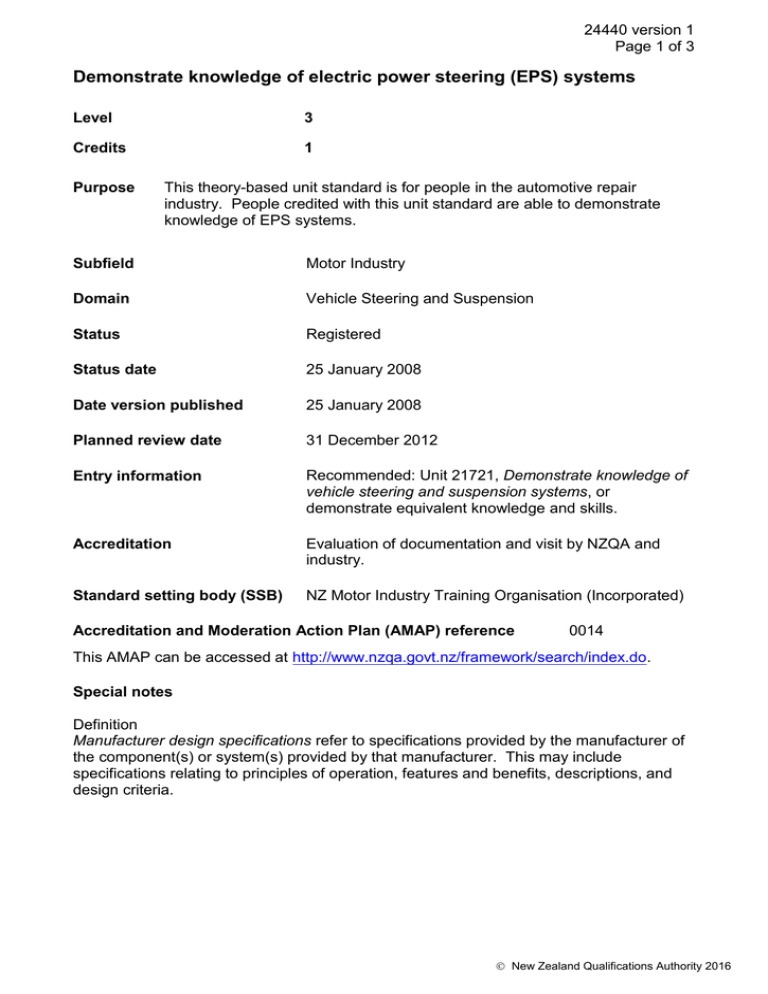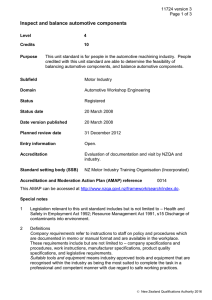Demonstrate knowledge of electric power steering (EPS) systems
advertisement

24440 version 1 Page 1 of 3 Demonstrate knowledge of electric power steering (EPS) systems Level 3 Credits 1 Purpose This theory-based unit standard is for people in the automotive repair industry. People credited with this unit standard are able to demonstrate knowledge of EPS systems. Subfield Motor Industry Domain Vehicle Steering and Suspension Status Registered Status date 25 January 2008 Date version published 25 January 2008 Planned review date 31 December 2012 Entry information Recommended: Unit 21721, Demonstrate knowledge of vehicle steering and suspension systems, or demonstrate equivalent knowledge and skills. Accreditation Evaluation of documentation and visit by NZQA and industry. Standard setting body (SSB) NZ Motor Industry Training Organisation (Incorporated) Accreditation and Moderation Action Plan (AMAP) reference 0014 This AMAP can be accessed at http://www.nzqa.govt.nz/framework/search/index.do. Special notes Definition Manufacturer design specifications refer to specifications provided by the manufacturer of the component(s) or system(s) provided by that manufacturer. This may include specifications relating to principles of operation, features and benefits, descriptions, and design criteria. New Zealand Qualifications Authority 2016 24440 version 1 Page 2 of 3 Elements and performance criteria Element 1 Demonstrate knowledge of EPS systems. Performance criteria 1.1 Types of EPS systems are described in accordance with manufacturer design specifications. Range 1.2 includes but is not limited to – column type, pinion type, rack type, double pinion type. An EPS system circuit layout is described in block diagram form in accordance with manufacturer design specifications. Range one of – column type, pinion type, rack type, double pinion type. 1.3 Features of an EPS system compared to a hydraulic power-assisted system are described in accordance with manufacturer design specifications. 1.4 The operating principle of an EPS is described in accordance with manufacturer design specifications. Range 1.5 mechanical construction, electronic construction. The functions of EPS components are described in accordance with manufacturer design specifications. Range includes but is not limited to – torque sensor, electronic control unit, motor. Please note Providers must be accredited by NZQA, or an inter-institutional body with delegated authority for quality assurance, before they can report credits from assessment against unit standards or deliver courses of study leading to that assessment. Industry Training Organisations must be accredited by NZQA before they can register credits from assessment against unit standards. Accredited providers and Industry Training Organisations assessing against unit standards must engage with the moderation system that applies to those standards. New Zealand Qualifications Authority 2016 24440 version 1 Page 3 of 3 Accreditation requirements and an outline of the moderation system that applies to this standard are outlined in the Accreditation and Moderation Action Plan (AMAP). The AMAP also includes useful information about special requirements for organisations wishing to develop education and training programmes, such as minimum qualifications for tutors and assessors, and special resource requirements. Comments on this unit standard Please contact the NZ Motor Industry Training Organisation (Incorporated) info@mito.org.nz if you wish to suggest changes to the content of this unit standard. New Zealand Qualifications Authority 2016









